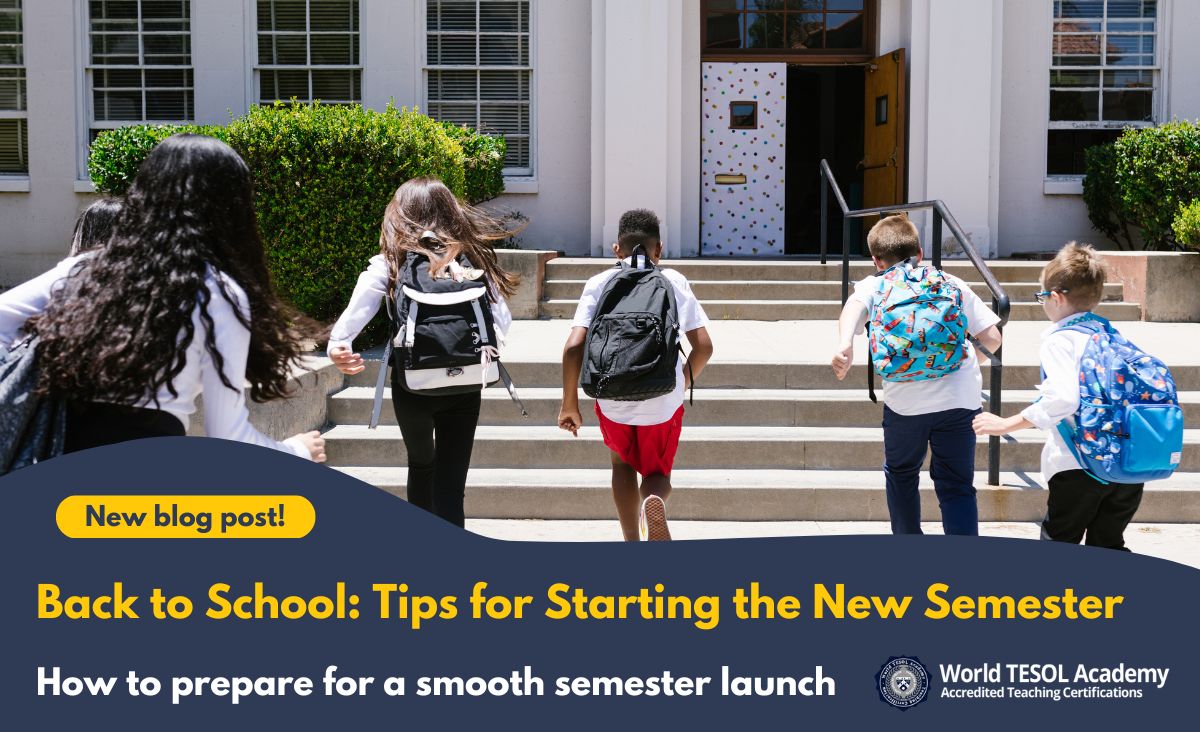
Back to School: Tips for Starting the New Semester
As many teaching destinations are nearing the end of the summer break, it’s time for ESL teachers to once more prepare for their return to the new semester. To ensure that your students get the smoothest possible start, it’s essential that you spend some time preparing yourself before stepping into the classroom.
As educators, the anticipation of a new semester brings with it a unique blend of excitement and responsibility. The opportunity to guide and inspire students on their educational journey is a privilege that requires careful preparation. From getting acquainted with the curriculum and lesson plans to establishing a welcoming and effective learning environment, English teachers play a crucial role in shaping the trajectory of the new semester.
In this blog post, we’ll go over practical strategies that you can use as an English teacher to prepare for your return to the classroom.
We’ll explore how to create a welcoming learning environment, effective icebreakers, the importance of classroom rules, and how to use diagnostic assessments and review activities to help your students begin the new academic year in a relaxed and confident manner.

Preparing your lessons
Before setting foot in the classroom and meeting your students, you should first make sure that you’ve familiarized yourself with the curriculum for the new semester.
If you are responsible for preparing your own lesson plans, now is a great time to start researching and creating the outlines for them so that you are able to able to stay efficient and modify them as the need arises.
By starting your lesson preparations early, you’ll also be able to prepare suitable activities that can be used to teach the target language of each lesson.
For example: If the target language of the lesson is to teach how to give and take directions, you can prepare a roleplaying activity where your students get to act out a real-life situation where they would be able to use the relevant target language.
If your employer is providing you with pre-made lesson plans, make sure that you go over them thoroughly to ensure that you are familiar with the topics that you are expected to cover, as well as the pace of the classes. Doing so will allow you to plan more efficiently and minimize stress.

Welcoming your students
As you will be spending a lot of time together in the classroom, it’s important that you work on creating an inviting and open classroom atmosphere where your students can feel secure enough to freely express themselves and be comfortable making mistakes without being judged.
A good way to set the tone right from the start is by greeting each student as they enter the classroom.
For example: If you are teaching students from a previous semester, you can welcome them back and tell them that it’s nice to see them again. If you are teaching new students, you can greet them individually as they enter and then welcome them to take a seat in the classroom.
By providing your students with a welcoming learning environment where they can feel seen and heard, you will be able to build rapport more easily which in turn can lead to a trusting relationship with your students.

Breaking the ice
Starting a new semester after a few weeks of holiday can be a bit nervous and pressuring for both teachers and students alike. Once all of your students are seated, start by welcoming them to the new semester. If you have new students in your class, make sure that you also properly introduce yourself.
To start off the first lesson in a lighthearted and fun way, you can follow up with an icebreaker activity that focuses on letting your students know more about each other.
For example: “Find someone who” is a fun icebreaker that allows you to promote social interaction while building a communal atmosphere in the classroom. Encourage your students to share personal experiences, express their opinions, and engage in meaningful conversations.
If you are teaching new students, you can have them introduce themselves to the class by sharing their names and something fun that they like to do. If your students are returning from the previous semester and already know each other, you can have them briefly share what they’ve done during their holiday break.

Introducing classroom rules
To help lay the foundation for an effective and disturbance-free learning environment, make sure that you introduce the classroom policies early on so that you are students are familiar with the types of behavior and policies that are expected to be followed in the classroom.
For example: This can include, phone usage policies, conduct rules such as how to call for attention, assignment deadlines, etc.
If your employer has specific classroom policies in place, make sure that you are well familiar with them to ensure that you meet the expectations that you have on you as a teacher. Remember, when working for an employer, you are also a representative of the company/school, meaning that your conduct in the classroom reflects the reputation of the employer.
Getting your TESOL/TEFL certificate: To teach English overseas and online, you’ll need to have an accredited and recognized TESOL/TEFL certificate.
If you haven’t yet enrolled in the course, you can do so here:
.

Diagnostic assessments activities
Diagnostic assessment activities are an effective tool that you can use at the beginning of the semester to both assess new students’ proficiency levels, as well as identify which areas your returning students need to review and focus a bit more on before introducing new knowledge.
These assessments can include listening, speaking, reading, and writing exercises that focus on both previously taught topics and new knowledge that you will be introducing during the semester.
For example: You can use diagnostic assessment activities such as quizzes, fill-the-gap sheets, role-playing activities, etc.
To avoid creating unnecessary pressure at the start of the semester, let them know that the diagnostic assessments don’t count toward their final grade. The purpose is simply for you to get a baseline of the current level of your students and how much review is needed before continuing with the new materials.

Scaffolded review activities
Once you have a better understanding of your students’ current proficiency levels and learning needs, it will be easier for you to decide if review activities are needed before moving on to the target language of the new semester.
If you find that your students are in need of reviewing previously learned topics, a good approach is to use scaffolding. By breaking down the previously learned concepts into smaller chunks, your students will be able to easily and quickly refresh their understanding before moving on to new topics.
For example: You can start with a brief recap of the target language to help your students jog their memory. After this, you can continue with introducing a fun review activity like role-playing that allows your students to use the target language in authentic contexts. Using teaching tools like visual aids, graphic organizers, and real-life examples is also a great and easy way to revisit past topics and trigger memory recall.
Make sure that the review activities you choose are engaging and relevant, as this can help make the learning process more enjoyable and memorable. Once you feel that they have a sufficient grasp of the previously learned topics, you can start introducing new concepts that build upon this knowledge.
Final thoughts
The start of a new semester marks the beginning of a journey toward knowledge and achievement. To ensure that your students are set up to have a productive semester, it’s crucial that you prepare well before setting foot in the classroom.
Familiarizing yourself with the new curriculum and preparing engaging lesson plans, allows you to create a solid foundation for delivering meaningful learning experiences, while simple gestures like properly welcoming your students and breaking the ice can help pave the way for developing a good communal atmosphere in the classroom.
To help your students refresh their knowledge, diagnostic assessments and scaffolded review activities can be used to ensure that your lessons meet the learning needs of your students. Let us remember that the foundation for student success is built upon the dedication and preparation of their teachers.




Leave A Comment